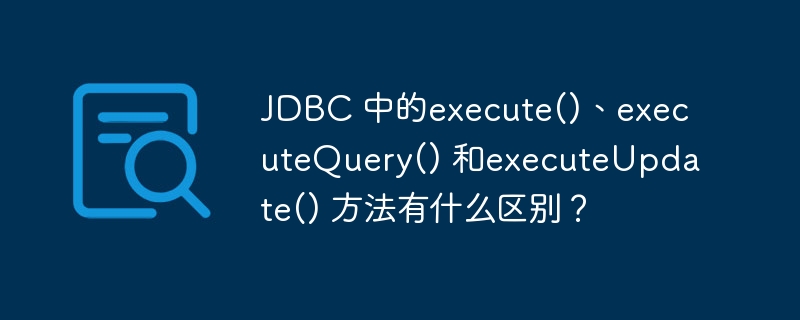JDBC 中的execute()、executeQuery() 和executeUpdate() 方法有什麼不同?

一旦您建立了語句對象,您可以使用Statement介面的execute()、executeUpdate()和executeQuery()方法之一來執行它。
execute()方法:該方法用於執行SQL DDL語句,它會傳回一個布林值,指定是否可以檢索ResultSet物件。
範例
import java.sql.Connection;
import java.sql.DriverManager;
import java.sql.SQLException;
import java.sql.Statement;
public class Example {
public static void main(String args[]) throws SQLException {
//Registering the Driver
DriverManager.registerDriver(new com.mysql.jdbc.Driver());
//Getting the connection
String mysqlUrl = "jdbc:mysql://localhost/sampleDB";
Connection con = DriverManager.getConnection(mysqlUrl, "root", "password");
System.out.println("Connection established......");
//Creating the Statement
Statement stmt = con.createStatement();
//Executing the statement
String createTable = "CREATE TABLE Employee( "
+ "Name VARCHAR(255), "
+ "Salary INT NOT NULL, "
+ "Location VARCHAR(255))";
boolean bool = stmt.execute(createTable);
System.out.println(bool);
}
}輸出
Connection established...... false
executeUpdate(): 這個方法用來執行插入、更新、刪除等語句。它傳回一個整數值,表示受影響的行數。
範例
import java.sql.Connection;
import java.sql.DriverManager;
import java.sql.SQLException;
import java.sql.Statement;
public class ExecuteUpdateExample {
public static void main(String args[]) throws SQLException {
//Registering the Driver
DriverManager.registerDriver(new com.mysql.jdbc.Driver());
//Getting the connection
String mysqlUrl = "jdbc:mysql://localhost/sampleDB";
Connection con = DriverManager.getConnection(mysqlUrl, "root", "password");
System.out.println("Connection established......");
//Creating the Statement
Statement stmt = con.createStatement();
String insertData = "INSERT INTO Employee("
+ "Name, Salary, Location) VALUES "
+ "('Amit', 30000, 'Hyderabad'), "
+ "('Kalyan', 40000, 'Vishakhapatnam'), "
+ "('Renuka', 50000, 'Delhi'), "
+ "('Archana', 15000, 'Mumbai')";
int i = stmt.executeUpdate(insertData);
System.out.println("Rows inserted: "+i);
}
}輸出
Connection established...... Rows inserted: 4
executeQuery():此方法用於執行傳回表格資料的語句(例如 select)。它傳回 ResultSet 類別的物件。
範例
import java.sql.Connection;
import java.sql.DriverManager;
import java.sql.ResultSet;
import java.sql.SQLException;
import java.sql.Statement;
public class ExecuteQueryExample {
public static void main(String args[]) throws SQLException {
//Registering the Driver
DriverManager.registerDriver(new com.mysql.jdbc.Driver());
//Getting the connection
String mysqlUrl = "jdbc:mysql://localhost/sampleDB";
Connection con = DriverManager.getConnection(mysqlUrl, "root", "password");
System.out.println("Connection established......");
//Creating the Statement
Statement stmt = con.createStatement();
//Retrieving data
ResultSet rs = stmt.executeQuery("Select *from Employee");
while(rs.next()) {
System.out.print("Name: "+rs.getString("Name")+", ");
System.out.print("Salary: "+rs.getInt("Salary")+", ");
System.out.print("City: "+rs.getString("Location"));
System.out.println();
}
}
}輸出
Connection established...... Name: Amit, Salary: 30000, City: Hyderabad Name: Kalyan, Salary: 40000, City: Vishakhapatnam Name: Renuka, Salary: 50000, City: Delhi Name: Archana, Salary: 15000, City: Mumbai
以上是JDBC 中的execute()、executeQuery() 和executeUpdate() 方法有什麼不同?的詳細內容。更多資訊請關注PHP中文網其他相關文章!

熱AI工具

Undresser.AI Undress
人工智慧驅動的應用程序,用於創建逼真的裸體照片

AI Clothes Remover
用於從照片中去除衣服的線上人工智慧工具。

Undress AI Tool
免費脫衣圖片

Clothoff.io
AI脫衣器

Video Face Swap
使用我們完全免費的人工智慧換臉工具,輕鬆在任何影片中換臉!

熱門文章

熱工具

記事本++7.3.1
好用且免費的程式碼編輯器

SublimeText3漢化版
中文版,非常好用

禪工作室 13.0.1
強大的PHP整合開發環境

Dreamweaver CS6
視覺化網頁開發工具

SublimeText3 Mac版
神級程式碼編輯軟體(SublimeText3)
 與MySQL中使用索引相比,全表掃描何時可以更快?
Apr 09, 2025 am 12:05 AM
與MySQL中使用索引相比,全表掃描何時可以更快?
Apr 09, 2025 am 12:05 AM
全表掃描在MySQL中可能比使用索引更快,具體情況包括:1)數據量較小時;2)查詢返回大量數據時;3)索引列不具備高選擇性時;4)複雜查詢時。通過分析查詢計劃、優化索引、避免過度索引和定期維護表,可以在實際應用中做出最優選擇。
 可以在 Windows 7 上安裝 mysql 嗎
Apr 08, 2025 pm 03:21 PM
可以在 Windows 7 上安裝 mysql 嗎
Apr 08, 2025 pm 03:21 PM
是的,可以在 Windows 7 上安裝 MySQL,雖然微軟已停止支持 Windows 7,但 MySQL 仍兼容它。不過,安裝過程中需要注意以下幾點:下載適用於 Windows 的 MySQL 安裝程序。選擇合適的 MySQL 版本(社區版或企業版)。安裝過程中選擇適當的安裝目錄和字符集。設置 root 用戶密碼,並妥善保管。連接數據庫進行測試。注意 Windows 7 上的兼容性問題和安全性問題,建議升級到受支持的操作系統。
 mysql:簡單的概念,用於輕鬆學習
Apr 10, 2025 am 09:29 AM
mysql:簡單的概念,用於輕鬆學習
Apr 10, 2025 am 09:29 AM
MySQL是一個開源的關係型數據庫管理系統。 1)創建數據庫和表:使用CREATEDATABASE和CREATETABLE命令。 2)基本操作:INSERT、UPDATE、DELETE和SELECT。 3)高級操作:JOIN、子查詢和事務處理。 4)調試技巧:檢查語法、數據類型和權限。 5)優化建議:使用索引、避免SELECT*和使用事務。
 mysql 和 mariadb 可以共存嗎
Apr 08, 2025 pm 02:27 PM
mysql 和 mariadb 可以共存嗎
Apr 08, 2025 pm 02:27 PM
MySQL 和 MariaDB 可以共存,但需要謹慎配置。關鍵在於為每個數據庫分配不同的端口號和數據目錄,並調整內存分配和緩存大小等參數。連接池、應用程序配置和版本差異也需要考慮,需要仔細測試和規劃以避免陷阱。在資源有限的情況下,同時運行兩個數據庫可能會導致性能問題。
 RDS MySQL 與 Redshift 零 ETL 集成
Apr 08, 2025 pm 07:06 PM
RDS MySQL 與 Redshift 零 ETL 集成
Apr 08, 2025 pm 07:06 PM
數據集成簡化:AmazonRDSMySQL與Redshift的零ETL集成高效的數據集成是數據驅動型組織的核心。傳統的ETL(提取、轉換、加載)流程複雜且耗時,尤其是在將數據庫(例如AmazonRDSMySQL)與數據倉庫(例如Redshift)集成時。然而,AWS提供的零ETL集成方案徹底改變了這一現狀,為從RDSMySQL到Redshift的數據遷移提供了簡化、近乎實時的解決方案。本文將深入探討RDSMySQL零ETL與Redshift集成,闡述其工作原理以及為數據工程師和開發者帶來的優勢。
 mysql用戶和數據庫的關係
Apr 08, 2025 pm 07:15 PM
mysql用戶和數據庫的關係
Apr 08, 2025 pm 07:15 PM
MySQL 數據庫中,用戶和數據庫的關係通過權限和表定義。用戶擁有用戶名和密碼,用於訪問數據庫。權限通過 GRANT 命令授予,而表由 CREATE TABLE 命令創建。要建立用戶和數據庫之間的關係,需創建數據庫、創建用戶,然後授予權限。
 Bangla 部分模型檢索中的 Laravel Eloquent ORM)
Apr 08, 2025 pm 02:06 PM
Bangla 部分模型檢索中的 Laravel Eloquent ORM)
Apr 08, 2025 pm 02:06 PM
LaravelEloquent模型檢索:輕鬆獲取數據庫數據EloquentORM提供了簡潔易懂的方式來操作數據庫。本文將詳細介紹各種Eloquent模型檢索技巧,助您高效地從數據庫中獲取數據。 1.獲取所有記錄使用all()方法可以獲取數據庫表中的所有記錄:useApp\Models\Post;$posts=Post::all();這將返回一個集合(Collection)。您可以使用foreach循環或其他集合方法訪問數據:foreach($postsas$post){echo$post->
 MySQL:初學者的數據管理易用性
Apr 09, 2025 am 12:07 AM
MySQL:初學者的數據管理易用性
Apr 09, 2025 am 12:07 AM
MySQL適合初學者使用,因為它安裝簡單、功能強大且易於管理數據。 1.安裝和配置簡單,適用於多種操作系統。 2.支持基本操作如創建數據庫和表、插入、查詢、更新和刪除數據。 3.提供高級功能如JOIN操作和子查詢。 4.可以通過索引、查詢優化和分錶分區來提升性能。 5.支持備份、恢復和安全措施,確保數據的安全和一致性。






